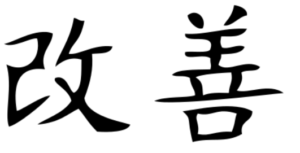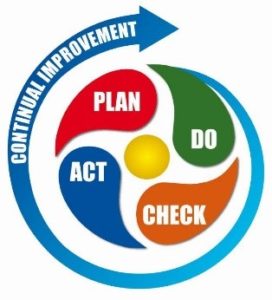Introduction
Kaizen is the Japanese word for “improvement,” and in business activities, Kaizen describes the structured analysis activities supporting continual workplace improvement that involve all employees. The goal of Kaizen is proactively improving work processes and operations to eliminate waste across all organizational boundaries without regard to silos commonly found in many organizations.

Kaizen was first introduced to the Japanese business universe, after the Second World War, influenced primarily by American business and quality-management consultants, especially Dr. W. Edwards Deming who was invited by Japanese industrial leaders to help rebuild post-war Japan. Kaizen has since spread throughout the globe and has been applied successfully for use by private and public sector organizations.
Kaizen Dimensions
Kaizen is described with two dimensions as follows:
Action Plan
Kaizen is about organizing events focused on improving specific areas within an organization.
Kaizen as an Action Plan is through a consistent and sustained program of successful Kaizen events, and it empowers employees to think differently about their work. In summary, the consistent application of Kaizen as an Action Plan creates tremendous long-term value by developing the culture that needed for beneficial continuous improvement.
Philosophy
Kaizen is about creating a culture where all employees are proactively engaged in identifying, suggesting, and implementing workplace improvements.
Kaizen Approaches
There are two analysis approaches supported by Kaizen:
- Flow Kaizen
- Process Kaizen
The Flow Kaizen approach supports the flow of materials and information and generally identified with the analysis and reorganization of an enterprise, department, or unit. Process Kaizen involves the improvement of individual processes or activities, improving the way workers do their job as organized within roles and responsibilities.
The use of Kaizen for continuous improvement requires that Flow and Process Kaizens jointly used. In Process Kaizen, stakeholders typically focus on identifying small changes (low-hanging fruit) for immediate implementation though this contrasts with traditional productivity improvement methods, which generally have a long lag between concept development and project implementation.
“If you do not know how to ask the right question, you discover nothing.”
W. Edwards Deming
Kaizen Value and Benefits
The value and benefits realized by organizations who successfully use the Kaizen approach include:
- Bottom-up problem-solving.
- Humanize workplace.
- Less waste: inventory is used more efficiently as are employee skills.
- Eliminate overly hard work (Muri).
- Improved consumer satisfaction: resulting from improved quality products with fewer faults.
- Improved competitiveness: increases in efficiency tend to contribute to lower costs and higher quality products.
People at all levels of an organization participate in Kaizen, as well as external stakeholders when applicable. Kaizen is most commonly associated with manufacturing operations, as at Toyota, and as well accepted in non-manufacturing environments.
Kaizen Waste Reduction: Examples
Examples of Kaizen waste reduction include:
- Decrease Over-Processing: (streamlining): eliminate doing more to the product than necessary to provide to improve value for money.
- Optimize Process Time: eliminate waiting time and gaps in the work process.
- Reduce Defects: eliminate re-work and thrown away defective products.
- Speed-up Movement: increase the velocity of materials to support the work and production cycles.
Kaizen Method Implementation
The Kaizen method is used within the structured phases as outlined below:
- Plan – develop a hypothesis.
- Do – experiment.
- Check – evaluate results.
- Act – refine experiment / start a new cycle.

Dr. W. Edwards Deming: Philosophy of Continuous Improvement
Dr. Deming, in his book “Out of the Crisis,” identified the 14 points of continuous improvement as outlined below.
- Create constancy of purpose toward improvement of product and service, to become competitive and to stay in business and to provide jobs.
- Adopt the new philosophy.
- Eliminate the need for inspection on a mass basis by building quality into the product in the first place.
- End the practice of awarding business based on the price tag. Instead, minimize total cost.
- Improve continually and forever, the system of production and service to improve quality and productivity and thus steadily decrease costs.
- Institute training on the job.
- Institute leadership. The aim of supervision should be to help people and machines and gadgets to do a better job.
- Drive out fear so that everyone may work effectively for the company.
- Break down barriers between departments. People in research, design, sales, and production must work as a team to foresee problems of production and use of the product or service.
- Eliminate asking for zero defects and new levels of productivity. Such exhortations only create adversarial relationships as the bulk of the causes of low quality and low productivity belong to the system and thus lie beyond the power of the workforce.
- Remove barriers that rob the hourly worker of his right to pride in craft.
- Remove barriers that rob people in management and the engineering of their right to pride in quality.
- Institute a vigorous program of education and self-improvement.
- Put everybody in the company to work to accomplish the transformation. The transformation is everybody’s job.
“No one knows the cost of a defective product – don’t tell me you do. You know the cost of replacing it, but not the cost of a dissatisfied customer.”
W. Edwards Deming



0 Comments